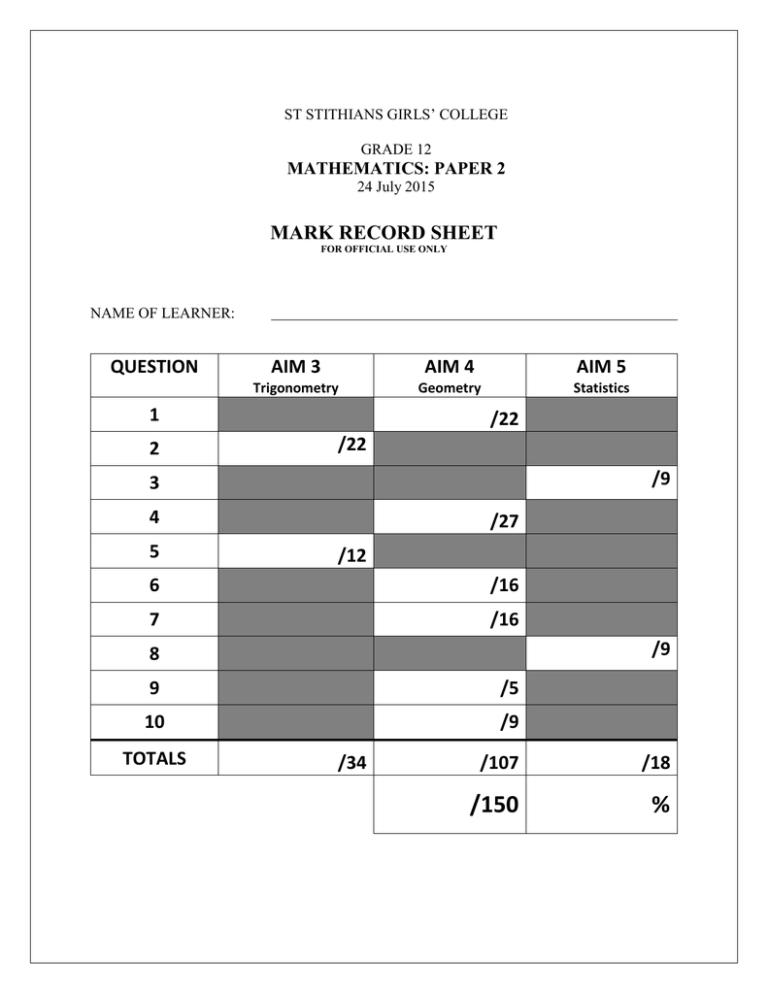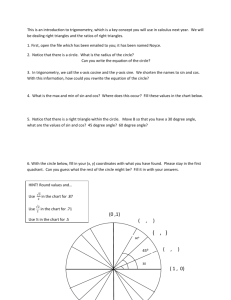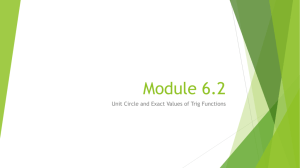Cluster North 143 Prelim Paper 2 2015
advertisement

ST STITHIANS GIRLS’ COLLEGE GRADE 12 MATHEMATICS: PAPER 2 24 July 2015 MARK RECORD SHEET FOR OFFICIAL USE ONLY NAME OF LEARNER: QUESTION AIM 3 AIM 4 AIM 5 Trigonometry Geometry Statistics 1 2 /22 /22 /9 3 4 5 /27 /12 6 /16 7 /16 /9 8 9 /5 10 /9 TOTALS /34 /107 /18 /150 % ST STITHIANS COLLEGE GRADE 12 MATHEMATICS PRELIM EXAM – PAPER 2 DATE: 24 July 2015 TIME: 180 minutes TOPICS: Paper 2 TOTAL MARKS: 150 EXAMINER: Cluster N143 MODERATOR: Cluster N143 INSTRUCTIONS: 1. This paper consists of 10 questions. Answer ALL of the questions. 2. This question paper consists of 22 pages. 3. Clearly show ALL calculations you have used to determine the answers. 4. An approved scientific calculator (non-programmable and non-graphical) may be used, unless otherwise specified. 5. If necessary, answers should be rounded off to TWO decimal digits, unless stated otherwise. 6. Diagrams are not necessarily drawn to scale. 7. It is in your own interest to write legibly and to present your work neatly. 2 QUESTION 1 1.1) [22] 𝑀(1; 𝑏) is the midpoint of the line segment joining 𝐴(𝑎; 4) and 𝐵(5; 6). Find the values of 𝑎 and 𝑏. 1.2) (3) The points 𝐶(1; ‒ 2), 𝐷(5; 1) and 𝐸(𝑐 2 ; 𝑐 + 1) are collinear. Find the value(s) of 𝑐. (4) 3 1.3) Given points 𝐴(−2; 2), 𝐵(3; 4) and 𝐶(4; 0) on the Cartesian plane as sketched: B(3 ; 4) A(‒2 ; 2) C(4 ; 0) 𝑥 1.3.1) Calculate the size of 𝐴𝐶̂ 𝐵, rounded off to one decimal digit. (6) 1.3.2) Show that the midpoint, 𝑀, of 𝐴𝐶 is (1 ; 1). (2) 4 1.3.3) Determine the equation of the circle which has AC as a diameter. Give your answer in the form (𝑥 − 𝑎)2 + (𝑦 − 𝑏)2 = 𝑟 2 . 1.3.4) Determine by calculation, whether point 𝐵 lies inside or outside this circle. Give a reason for your answer. (3) (2) 1.3.5) Write down the value of the shortest distance from 𝐵 to the circle. (Leave your answer in surd form) (2) 5 QUESTION 2 [18] Refer to the diagram below. Given circle with centre O and equation x 2 y 2 20 . G ( m; 0) is the centre of the larger circle. A common tangent touches the circles at B and D respectively. y D C • O G (m;0) x B 2.1) B (t; 2) lies on the circumference of the small circle. Determine the value of t. (3) 2.2) C (6; 2) is the midpoint of BD. Determine the coordinates of D. (2) 6 2.3) Determine the gradient of DG. (3) 2.4) Show that m 20 (3) 2.5) Determine the equation of the circle with centre G. (3) 2.6) ˆ . Determine the size of angle OCB (4) 7 QUESTION 3 3.1) [22] Trigonometric functions 𝑓(𝑥) and 𝑔(𝑥) are given below, with 𝑥 ∈ [−90°; 360°]: 𝑓 𝑔 3.1.1) Write down the equations of 𝑓 and g. (2) 3.1.2) Write down the period of 𝑓. (1) 3.1.3) Write down the amplitude of 𝑔. (1) 3.1.4) Determine the values of x where 𝑓(𝑥). 𝑔(𝑥) ≥ 0 for 𝑥 ∈ [90° ; 270°] (4) 8 3.2) If 𝜃, 2𝜃 and 3𝜃 are the angles of a triangle, evaluate 𝑐𝑜𝑠 2 𝜃 + 𝑐𝑜𝑠 2 2𝜃 + 𝑐𝑜𝑠 2 3𝜃 without the use of a calculator: 3.3) (4) Without the use of a calculator, solve 𝑠𝑖𝑛32°𝑐𝑜𝑠𝑥 + 𝑐𝑜𝑠32°𝑠𝑖𝑛𝑥 = 𝑠𝑖𝑛75° for 𝑥, where −360° ≤ 𝑥 ≤ 360° ∶ (5) 9 3.4) You are riding the Colossus at Ratanga Junction and notice that consecutive peaks, T ( p;10) and L (10;8) , of the ride are in proportion to each other. You also notice as you are riding, that 𝐿𝑂̂𝐾 = 𝑆𝑂̂𝑇 = 𝛽. T (p ; 10) L (10 ; 8) S O K 3.4.1) Determine the value of cos(90° + 𝛽). (Leave your answer in surd form if necessary) 3.4.2) Determine the value of 𝑝. (3) (2) 10 QUESTION 4 [9] Mr Mears is curious to see the distribution of heights of all his History students. The table below summarises the individual heights (in cm) of 61 History students. 4.1) Complete the table by filling in the unknown values for (a) and (b): Height Intervals in cm 140 ≤ 𝑥 < 150 150 ≤ 𝑥 < 160 160 ≤ 𝑥 < 170 170 ≤ 𝑥 < 180 4.2) Frequency 0 5 11 (2) Cumulative Frequency 0 5 16 38 (a) 180 ≤ 𝑥 < 190 13 190 ≤ 𝑥 < 200 7 200 ≤ 𝑥 < 210 3 51 (b) 61 Below is an Ogive for the heights of the History students: Cumulative Frequency of Heights 70 60 50 40 30 20 10 0 150 160 170 180 11 190 200 210 Use the Ogive to estimate the values of 𝑄1, 𝑄2 and 𝑄3 , and show on the Ogive how you read off your answers. 4.2.1) 𝑄1 (1) 4.2.2) 𝑄2 (1) 4.2.3) 𝑄3 (1) 4.3) Which height interval(s) contain(s) heights from the 90th percentile. 4.4) Use the table of information to calculate an estimate for the mean of the History students’ heights. (2) (2) 12 QUESTION 5 5.1) [20] In the figure O is the centre of the circle and 𝐷𝐵 = 𝐷𝐹. 𝐴𝐹, 𝐵𝐸 and 𝐵𝐹 are straight lines, and 𝐹̂ = 20°. E A 4 3 1 O 2 1 1 2 2 D 4 3 3 B 1 2 C F Find, with reasons, the magnitude of the following angles: ̂2 5.1.1) 𝐷 (3) 5.1.2) 𝐴̂ (3) 5.1.2) 𝑂̂2 (2) 5.1.3) 𝐶̂1 (2) 13 5.2) In the diagram below, parallelogram KLMN is given. 𝑇̂ is not the centre ̂1 = 24𝑜 . Determine the size of 𝑀 ̂1 . of the circle. 𝐿̂ = 66𝑜 and 𝑁 N 1 2 M 1 2 T 3 4 1 2 3 2 K 1 3 2 1 P 14 L (5) 5.3) An arch of a bridge is such that it is an arc of a circle and its height is 36m and its span is 96m. (i.e. CD 36m and AB 96m ). D A B C •O Calculate with reasons the radius OD of the arch, i.e. calculate the length of OD. (Hint Let OD x ) (5) 15 QUESTION 6 [16] 6.1) 𝑂𝐴𝐵𝐶𝐷 is a right pyramid with a square base with sides of length 4cm as shown in the diagram below. OÂB 50 and OA OB . O C B D A 6.1.1) Determine the length of OA. (2) 6.1.2) Determine the length OE, the slant height of triangle OAB, where E is the midpoint of AB. (3) 6.1.3) Show that the perpendicular height is … 16 (2) 6.1.4) Hence, or otherwise, calculate the volume of the pyramid. 6.2) (2) Given AB ll CD, AC 12 , CE 15 , DE 9 , BC 6 , Aˆ 42o and Eˆ 35o Find the Area of the shaded ΔBCD. A 8 42° C 6 15 35° D B 17 9 E (7) QUESTION 7 7.1.1) Prove the identity: [12] sin 2 2 x 2cos 2 x.cos x 2cos x cos x 7.1.2) Hence, determine the maximum value of 7.2) (5) sin 2 2 x 2 cos 2 x.cos x , and the value cos x of x to give this maximum, where 90 x 90 (2) Determine the general solution of: cos(25° − 2𝜃) = sin 4𝜃 (5) 18 QUESTION 9 [9] In the figure below, ΔABC has D and E on BC, BD 6cm and DC 9cm . AT : TC 2 :1 and AD ll TE. A T F C E B D CE ED 9.1) Write down the numerical value of (1) 9.2) Show that D is the midpoint of BE. (2) 9.3) If FD 2cm , calculate the length of TE. (2) 19 9.4) Calculate the numerical value of: 9.4.1) Area of ADC Area of ABD (1) 9.4.2) Area of TEC Area of ABC (3) 20 QUESTION 10 [10] Refer to the figure below. 𝐿𝑀 = 𝐾𝐿, and 𝐿𝑍 is a tangent to the circle at 𝐿. 𝑋𝑍 ∥ 𝐿𝑁 and 𝐾𝑀 produced meets 𝑋𝑍 at 𝑌. 𝐾𝑁𝑋 is a straight line. X 2 1 N 2 1 2 1 1 Y 1 M4 3 K 2 2 2 1 3 L Z 10.1) Prove that 𝑌𝐾||𝑍𝐿. (4) 21 10.2) Prove that ∆𝑋𝑌𝑀|||∆𝐾𝑌𝑋. (4) 10.3) Prove 𝑋𝑍. 𝑋𝑌 = 𝐾𝑌. 𝐿𝑍 (5) 22



